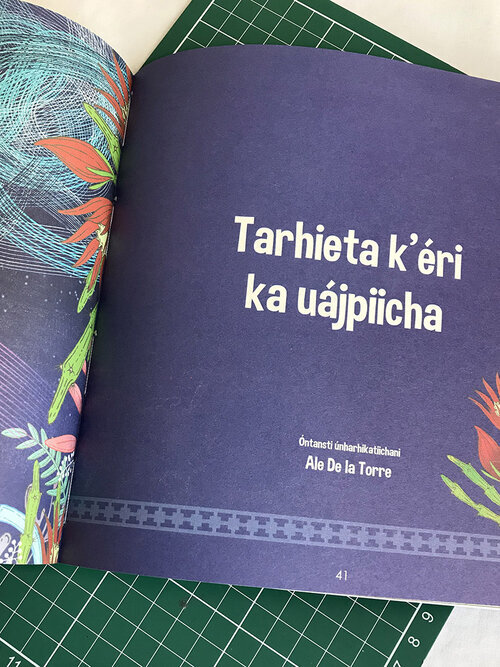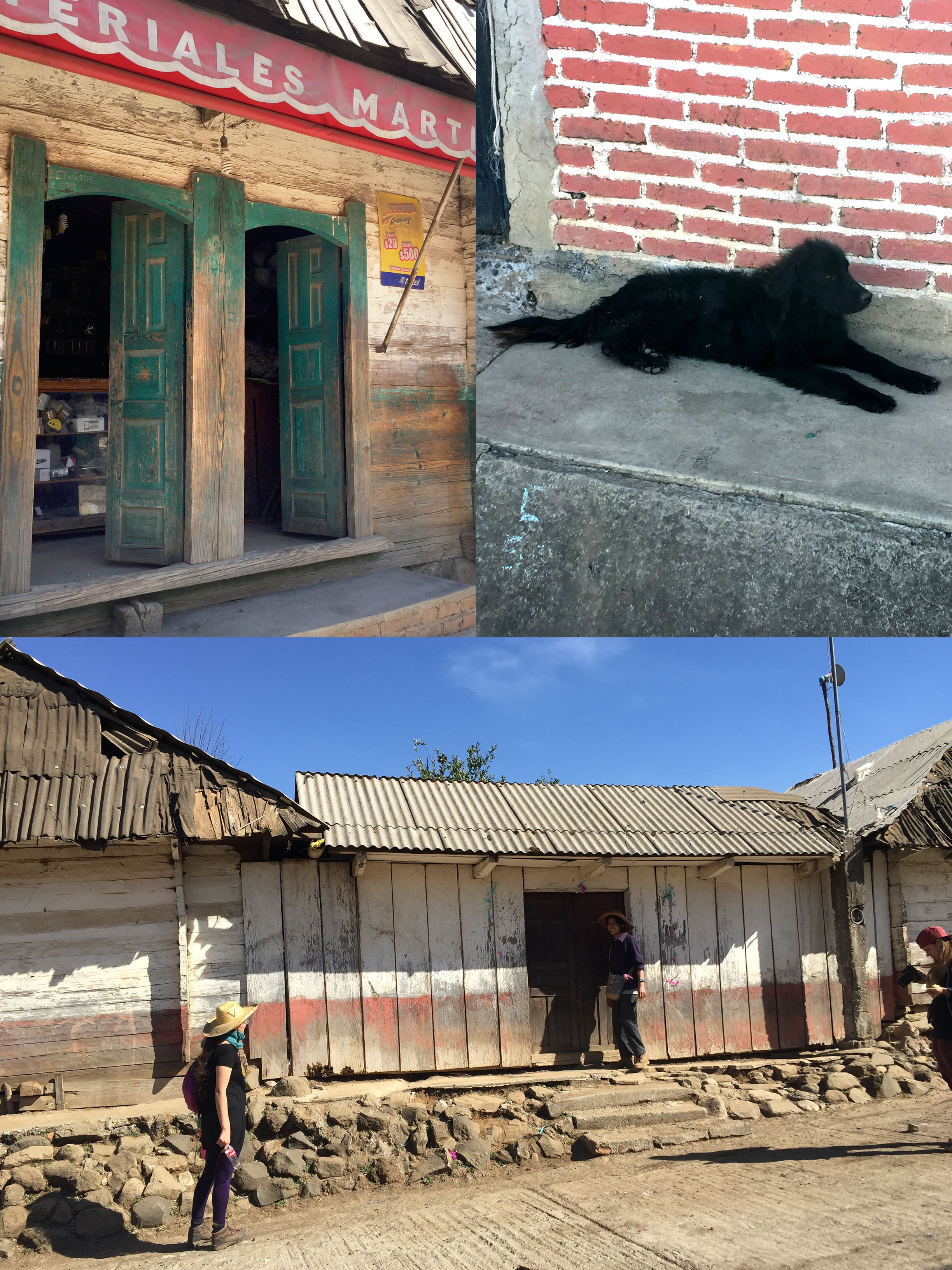¿T’úri mítiski na xani iónharhiski misiku?
By: Zuleyma Martínez
Art: Ale De la Torre, Ángel Pahumaba, Evelia Mora, Joel Astreo, Kitzia González.
Publisher: Laboratorio Nacional de Materiales Orales LANMO
Project: Children’s book illustration
ENG. I finally saw for the first time the book in which I participated with the illustrations of the story “The Wind and His Children.” This storybook in P'urhe was written by Zuleyma Martínez and illustrated by Michoacan artists: Ángel Pahumaba, Evelia Mora, Joel Astreo, Kitzia González.
The title of the book is “T’úri mitiski na xani iónharhiski misiku?” (Do you know how long the cat's face is?). Zuleyma wrote this book of stories inspired by the children of her community and faced with the need to create written texts in her native language aimed at children, she took on the task of finding the artist suitable for each story and invited us to their community to learn about the place where their stories take place. When I arrived in San Isidro, I immediately felt warmth and saw that it is surrounded by beautiful landscapes; From there you can see the Patamban hill with its very particular shape, a silhouette that remained engraved in my mind and that I included in the illustrations throughout the story. I also drew the Zuleyma family hardware store and the traditional structure of the San Isidro houses. As I walked through the town I could see all the things she talked about in her stories. There, the wind currents carry all kinds of objects and, as in the story I illustrated, they chase dogs and lift girls' skirts. On the hill of pines and oaks the ground is full of pine cones and huinomo, where the protagonist of another of his stories was surely born. We visited their kitchen, a traditional kitchen in which we spent hours watching how the smoke from the stove reached the sun's rays that filtered through small cracks in the ceiling. We spent a lot of time doing one of my favorite activities, walking around the hill observing the diversity of plants, from which I got many references for the illustrations. But probably one of the things that fascinated me most about this trip was hearing Zuleyma speak P'urhe, a beautiful language that, thanks to books like this, children may want to continue speaking and of which they are proud.
These are some of the photos that I took on the trip we made to San Isidro – a P’urhépecha comunity –, as a reference to make the illustrations of “Tarhieta k’eri ka uájpiicha” (“The wind and its children”), one of the stories in a book written by Zuleyma Martínez that are a mixture of fantasy and everyday life. The stories are inspired by this indigenous community in Michoacán, Mexico, where mischievous little winds can be found chasing dogs and kids, there are also macaws, huge ghosts, kites and even a girl made of huinumo (pine needles). Hope you like the illustrations we made with so much love for those amazing stories.
♡ ♡ ♡ ♡ ♡
ESP. Por fin vi por primera vez el libro al el que me invitaron a participar con las ilustraciones del cuento titulado “El viento y sus hijos”. Es un libro de cuentos en p’urhe escrito por Zuleyma Martinez e ilustrado por artistas Michoacanos: Ángel Pahumaba, Evelia Mora, Joel Astreo, Kitzia González.
El Título del libro es “¿T’úri mítiski na xani iónharhiski misiku?” (¿Tú sabes cuánto mide el largo de la cara del gato?) Zuleyma escribió este libro de cuentos inspirada en los niños de su comunidad y por la necesidad de crear textos escritos en su lengua materna dirigidos a niños, se encargó de buscar al artista adecuado para cada historia y nos invitó a su comunidad para poder conocer el lugar en el que suceden sus historias.
Cuando llegué a San Isidro, inmediatamente sentí calor y vi que está rodeado de paisajes hermosos; desde ahí se puede ver el cerro de Patamban con su muy particular forma, una silueta que se me quedó grabada y que incluí en las ilustraciones a lo largo del cuento. También dibujé la ferretería de la familia de Zuleyma y la estructura tradicional que tienen las casas de San Isidro. Conforme recorría el pueblo pude ver todas las cosas de las que ella hablaba en sus cuentos. Allá, las corrientes de viento arrastran todo tipo de objetos y, como en el cuento que ilustré, persiguen perros y levantan las faldas de las niñas. En el cerro de pinos y encinos el piso está lleno de conos y huinumo, de donde seguramente nació la protagonista de otro de sus cuentos. Conocimos su cocina, una cocina tradicional en la que duramos horas viendo el humo del fogón alcanzando los rayos del sol que se filtraban por pequeñas hendiduras en el techo. Pasamos mucho tiempo en una de mis actividades favoritas, caminar en el cerro viendo la diversidad de plantas, de la que saqué muchas referencias para las ilustraciones. Pero probablemente una de las cosas que más me fascinó de este viaje fue escuchar a Zuleyma hablando p’urhe, un idioma bellísimo que gracias a libros como este, es posible que los niños quieran seguir hablándolo y sentirse orgullosos de él.
Estas son algunas de las fotos que tomé en el viaje que hicimos a San Isidro, como referencia para hacer las ilustraciones de “Tarhieta k’eri ka uájpiicha” (“El viento y sus hijos2) uno de los cuentos del libro escrito por Zuleyma Martínez que son una mezcla de fantasía y de la vida cotidiana. Los cuentos están inspirados en esta comunidad indígena en Michoacán, México en donde podemos encontrar pequeños vientos traviesos que persiguen perros y niños, también hay guacamayas, fantasmas enormes, papalotes e incluso una niña hecha de huinumo (hojas de pino). Espero que les gusten las ilustraciones que hicimos con tanto cariño para estas fantásticas historias.
Los cuentos se sitúan en esta bella y tranquila comunidad P’urhépecha rodeada de cerros y son una mezcla de fantasía y de la vida cotidiana del lugar. En este libro hay perros, guacamayas, fantasmas, vientos traviesos, niños y hasta una niña hecha de huinumo. Espero que a los niños les guste mi interpretación de esa hermosa, bizarra historia.
En las fotos se pueden algunas variedades de plantas que yo, descuidadamente mezclé en las ilustraciones; el perro negro al que los vientos apedreaban, la tienda de materiales, el papel picado, el cielo siempre azul y soleado, el bello cerro de Patamban y los traviesos y crueles remolinos.
Estas son algunas ilustraciones que hice para el cuento “El viento y sus hijos”.
El viento y sus hijos. Art by Ale De la Torre. Mixed media illustration 2020.
EL VIENTO Y SUS HIJOS
P'URHÈ.
Uichu, tataka sapichu ka tanimu tarhieta sapirhatiicha sesi uarhixatiksï.
Taati, ¿anti xani k’érati tarhiasïni febreru kuts’ï jimpo?
ESP.
El perro, el niño y los tres vientos pequeños están bien muertos.
Padre, ¿por qué cada año, en el mes de febrero, hace tanto viento?
ENG.
The dog, the kid and the three little winds are dead.
Father, why is it so windy every year in February?
El viento y sus hijos. Art by Ale De la Torre. Mixed media illustration 2020.
La presentación del libro será el Miércoles, 17 de febrero de 2021 a las 18:00 en la página de FB del Laboratorio Nacional de Materiales Orales (LANMO).












